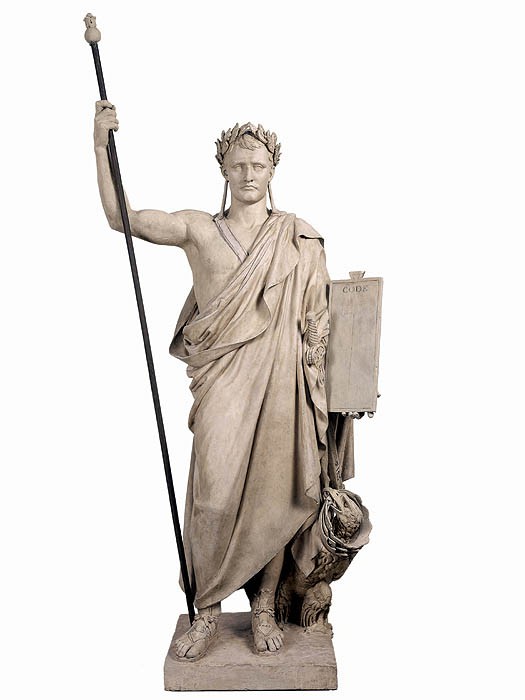Eugène Guillaume, author of this life-size statue, was an official artist during the Second Empire whose claim to fame was his mastery of Neoclassicism. He was trained by Jean-Jacques dit James Pradier (1790-1852, Grand Prix de Rome in 1813) who himself had found fame with his sculptures inspired by antiquity – including notably the “Victories” of the Hotel des Invalides.
Guillaume worked on the Parisian churches of Saint-Eustache, Sainte-Clotilde and Trinité and indeed on the Place Saint-Michel fountain prolonging his classicist sensitivity.
After winning the Prix de Rome in 1845, Eugène Guillaume began a career as an official artist, winning many honours on the way, finally to become director of the Académie de France in Rome in 1891 and appointed to the Duc d’Aumale chair at the Académie française in 1898.
His work includes an important Napoleonic cycle, for the most part commissioned by the Prince Napoléon (1822-1891), son of Jérôme Bonaparte. The prince had commissioned the architect Alfred-Nicolas Normand (1822-1909) to build a residence for him at 18 Avenue Montaigne in Paris. It was to be an imitation of an antique villa and known as the Maison Pompéienne (Pompeian House). For the atrium he had commissioned Guillaume to provide a full-length statue of Napoleon I as a Roman Emperor wearing a toga and holding in his hand the Code Civil, with a laurel wreath on his head and an eagle at his feet. The work presented here is the original plaster for that white marble statue. It was probably commissioned before 1859 (it appears in the salon guide for that year but was not to be presented until the exhibition of 1861). A painting by Gustave Boulanger, Rehearsal of “The flute player” and “The wife of Diomedes” in the atrium of Prince Napoleon’s “Maison Pompéienne” in 1860, (Musée de Versailles) shows the actors preparing for the show planned for the inauguration of the Maison on 14 February, 1860. The sculpture of Napoleon I by Guillaume can be seen in the painting, set on a high pedestal in the form of an antique fountain and dominating the atrium. The same scene is also reproduced in a series of photographs attributed to Laplanche (external links in French).
The Pompeian style was very much in fashion at the time: the site in Pompeii had been known since the eighteenth century and had already been celebrated in the popular imagination – most recently with the publication in 1852 of the new Arria Marcella by Théophile Gautier. A new excavation campaign undertaken by the Italian Giuseppe Fiorelli (1823-1896), trained as a numismatist, revolutionised the approach to the site at Pompeii. Using for the first time the technique of archaeological plaster cast in the imprints left by the bodies of the Pompeiians consumed by the ashes of Vesuvius, Fiorelli was able to resurrect the physical form of men, women and children who had perished in the tragedy of 79 AD.
Chateaubriand had meditated on the fragility of memory using the example of Pompeii (“In Portici they showed me a piece of Vesuvius ash, crumbly to the touch, and which still bore the imprint, every day more faded, of the breast and the arm of a young woman buried beneath the ruins of Pompeii; this is a fairly accurate image, although it is not yet quite in vain, of the trace left by our memory in the heart of men, dust and ashes”, Travels in Italy, 1803). However , these new archaeological techniques and indeed the enthusiasm they provoked, demonstrate the longevity of the Roman heritage. Artists flocked to the Antiquarium which from 1861 exhibited these rediscovered “bodies”. The statue of Napoleon as legislator by Eugène Guillaume, a fervent admirer of the Roman Empire, was part of the continuity of this ancient history. This Classical influence would also provide a strong direction to his career which he would finish as Director of the Villa Medici in Rome, where he died in 1905.
Whilst the plaster version was to remain in Guillaume’s atelier, later to be handed down to his descendants, the marble statue was to have a less tranquil destiny. When the Maison was sold in 1866, the statue was presented at the Exposition universelle of 1867 before suffering irreparable damage in the fire at the Tuileries Palace in 1871. Taken to the Château de Prangins, in Switzerland, that statue is today held at the Napoleon Museum in Arenenberg.
The Prince Napoleon also commissioned Guillaume to produce a series of busts of Napoleon. Set in the conservatory in the Maison Pompéienne, these represented the Emperor at different stages in his life, namely as a pupil at Brienne, as General in Chief of the Armée d’Italie, as First Consul, as Emperor, in 1812, and on St Helena (the plaster versions of these are at the Musée Malmaison and the marble versions are at Prangins and Arenenberg). A standing statue of Napoleon as an artillery lieutenant finished the cycle in 1870, however the Musée d’Orsay has wax sketches for an unexecuted equestrian statue of Napoleon, planned for the Cour Napoléon at the Louvre.
Karine Huguenaud, May 2005, updated October 2016 by Marie de Bruchard (tr. P. H. and R.Y.).
This work was on long-term loan to the Musée d’Orsay from December 2017 – June 2022 . See our photo album taken on the day of its installation in the nave of the museum (December 2017).


